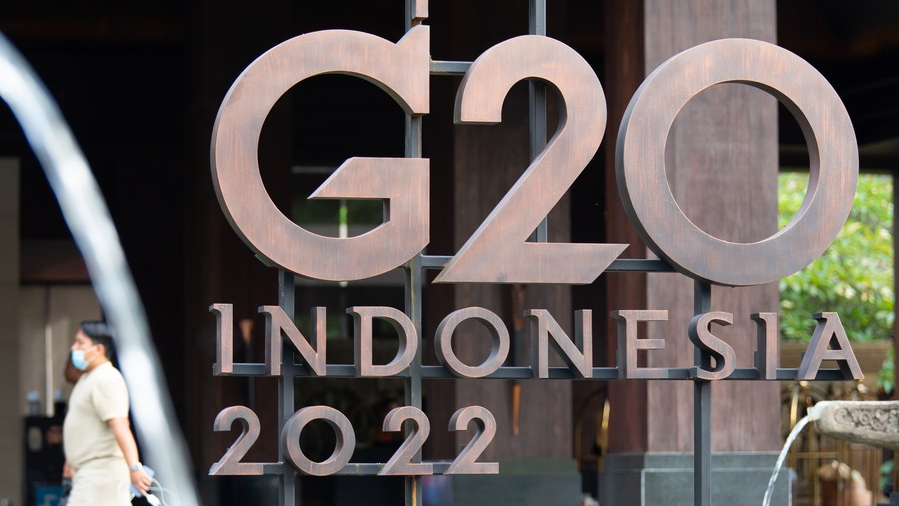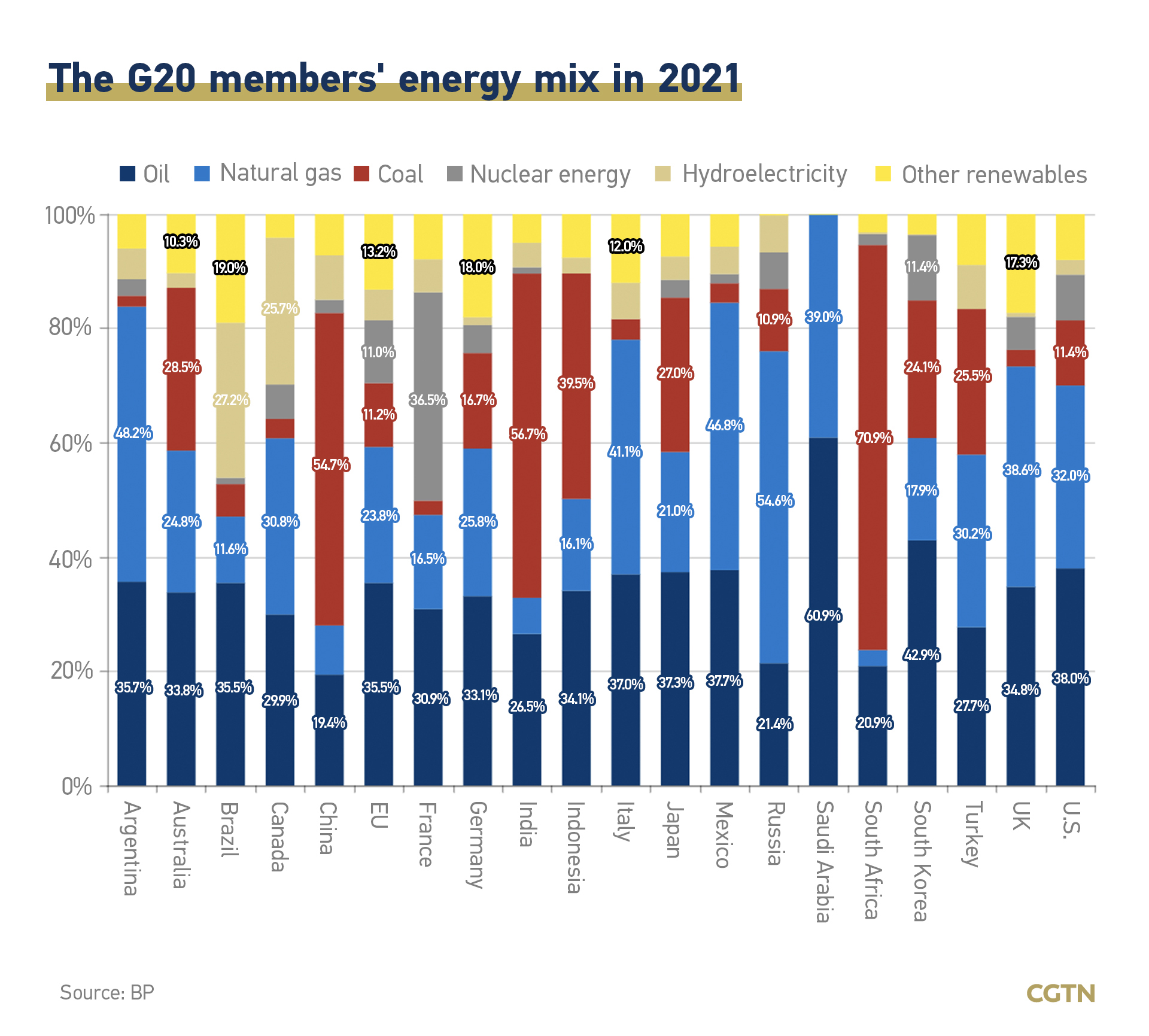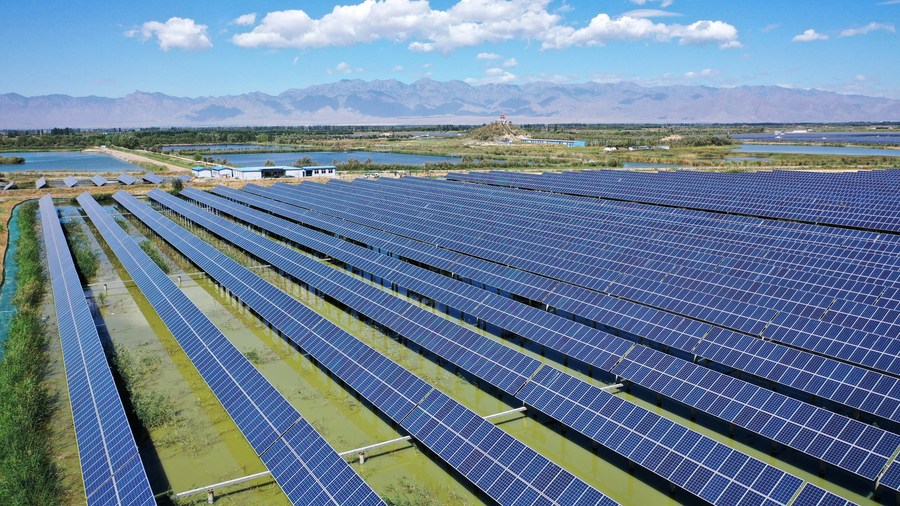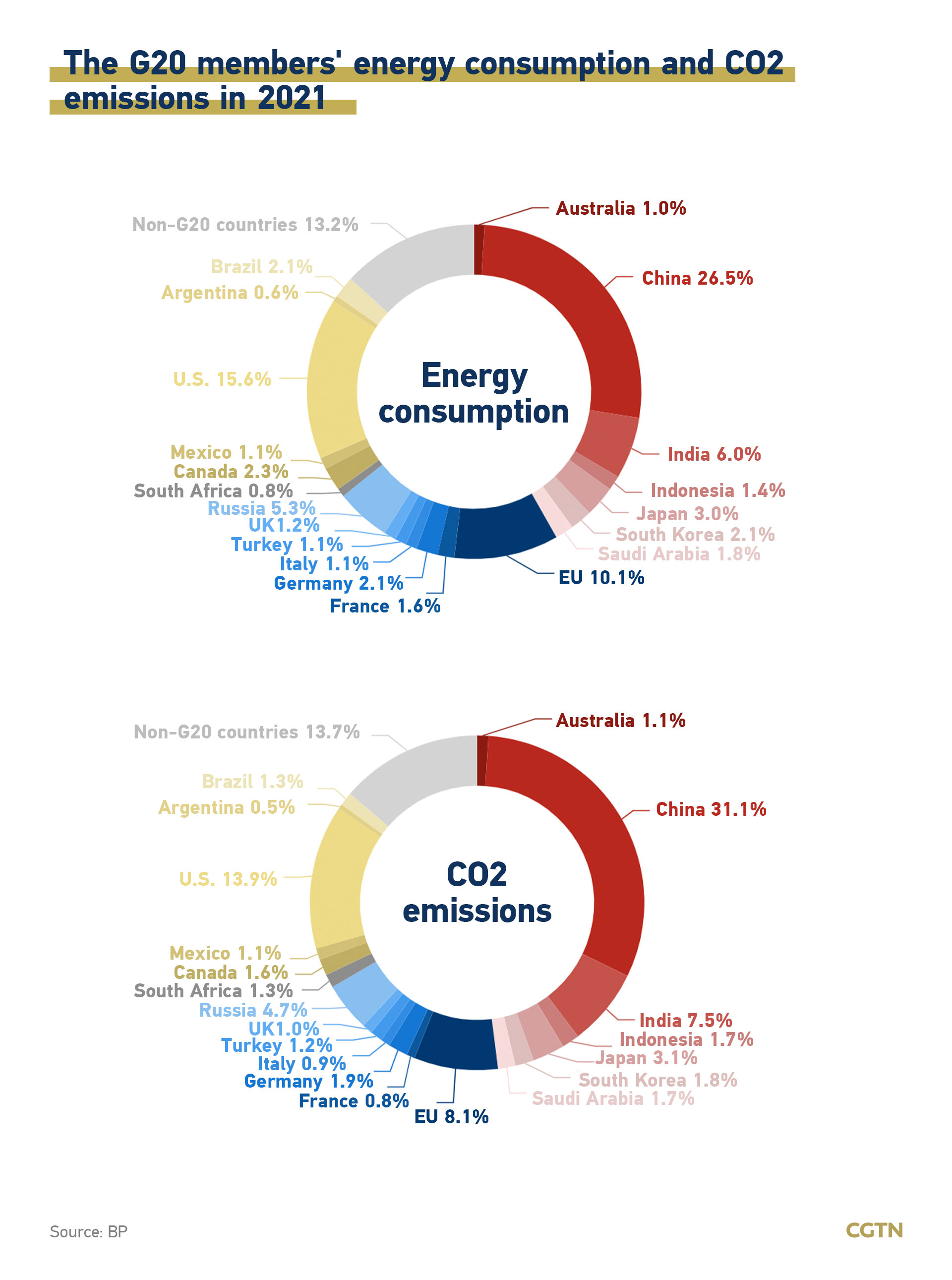
The logo for the 17th Group of 20 (G20) Summit outside Apurva Kempinski, the main venue for the summit in Bali, Indonesia, November 12, 2022. /Xinhua
The logo for the 17th Group of 20 (G20) Summit outside Apurva Kempinski, the main venue for the summit in Bali, Indonesia, November 12, 2022. /Xinhua
The 17th Group of 20 (G20) Summit has taken place on Tuesday in Bali, Indonesia. This year, sustainable energy transition has been one of the three main issues of the Summit, along with other two G20 priorities including global health architecture and digital transformation.
As an intergovernmental forum, the G20 is made of the world's major developed and emerging economies, which together represent two-thirds of the global population and 85 percent of global GDP.
Meanwhile, G20 economies consume around three-quarters of the global energy supply and account for around 80 percent of the world's annual greenhouse gas emissions.
"The G20 countries have agreed to accelerate energy transition, and to meet the sustainable global development targets by 2030, particularly on the access to reliable, sustainable, and affordable modern energy for all," said Yudo Dwinanda Priaadi, chair of the summit's Energy Transitions Working Group at an online press conference last Tuesday.
During the Energy Transitions Ministerial Meeting in September 2022, all G20 members agreed on the Bali Compact which contains basic principles to accelerate energy transitions, like securing sustainable energy supply and boosting energy efficiency measures.
Besides Bali Compact, the Bali Energy Transitions Roadmap has been proposed with focus on scaling up smart and clean energy technologies, as well as intensifying finance for the energy transition.
Changes in G20's energy mix
Over the last 50 years, the energy mix of the G20 countries has experienced a change with increased share of renewable energy and diversified energy mix.
The growing trend of renewables is expected to continue, driven by strong expansion in solar and wind energy.
In 2021, renewable energy led by wind and solar power accounts for nearly 13 percent of total power generation, surpassing the contribution of nuclear energy, according to the latest report of Statistical Review of World Energy by BP p.l.c. (BP), commonly known as British Petroleum, one of the world's largest integrated oil and gas companies. The company has been publishing its Statistical Review of World Energy since 1952.


China remained the main driver of solar and wind capacity growth in 2021, accounting for about 36 percent and 40 percent of global capacity additions respectively, according to BP's report.
As China is pursuing green development, its renewable energy capacity witnessed a rapid growth in the first nine months of 2022. The installed capacity of wind power rose 16.9 percent while solar power generation was up 28.8 percent, data from the National Energy Administration shows.
It is estimated that China will remain the leader in renewable capacity growth over the next five years, accounting for 43 percent of the total, followed by Europe, the U.S., and India. Together, the four markets take up 80 percent of renewable capacity expansion worldwide, according to a 2021 report by the International Energy Agency (IEA).

Aerial photo of photovoltaic panels at a fish breeding base in Helan County of Yinchuan, northwest China's Ningxia Hui Autonomous Region, August 24, 2021. /Xinhua
Aerial photo of photovoltaic panels at a fish breeding base in Helan County of Yinchuan, northwest China's Ningxia Hui Autonomous Region, August 24, 2021. /Xinhua
Low-carbon energy transition
Apart from shifting to renewable energy, improving energy efficiency is crucial to ensure the energy transition to a zero-carbon energy system. It helps to reduce waste, bring down the per-unit cost of lighting and heating, and cut greenhouse gas emissions.
Without the efficiency improvement made since 2000, the world would be using 13 percent more energy today, energy-related carbon emissions would be 14 percent higher, according to the 2022 report on Security of Clean Energy Transitions by the IEA.
Since 1965, the world average efficiency of fossil fuel-based power has risen from around 36 percent in 2000 to over 40 percent in 2021, and expected to rise to 45 percent in 2050, according to BP's report.
In 2014, the G20 placed energy efficiency on the agenda, with the G20 Energy Efficiency Action Plan was adopted as a result. In 2016, under China's G20 Presidency, collaboration was reinforced by the G20 Energy Efficiency Leading Program.

Along with the increase in energy efficiency is the cut-down of the use of fossil fuel.
Since the start of the Industrial Revolution in the 18th century, global fossil fuel use has risen with the GDP, which is accountable for large amounts of carbon dioxide released into the air. Except for 2020 at the height of the COVID-19 pandemic, carbon emissions have risen every year since the Paris goals were agreed upon, according to BP's report.
To decrease the share of fossil fuel in energy generation and curb CO2 emissions, G20 countries have extended carbon taxes or emission trading systems to encourage switching to more sustainable sources of energy and reducing emission-intensive activities.
In 2021, nearly half of all CO2 emissions from energy use in G20 economies are priced, up from 37 percent in 2018, according to a report on carbon pricing by the Organization for Economic Co-operation and Development (OECD).
Under the aim of limiting global warming to 1.5 to 2 degrees Celsius to avoid a climate catastrophe, G20 countries have developed a method for voluntary, country-led peer reviews of fossil-fuel support as a "valuable means of enhanced transparency and accountability" since 2013.
China and the U.S. became the first pair to carry out a voluntary peer review of their fossil fuel subsidies, which was completed in 2016.
Under China's commitment to peak its carbon dioxide (CO2) emissions by 2030 and reach carbon neutrality by 2060, more specific measures have been taken like doubling its 2020 installed wind and solar capacity by 2025.
Despite of the progress, challenges are lying ahead amid the weakening global economy and uncertainties caused by the COVID-19 pandemic and geopolitical tensions.
BP's report pointed out that the world remains on an unsustainable path, as challenges including Russia's action sit alongside the need to achieve decarbonization and meet the Paris climate goals.
"G20 economies are lifting their ambition and efforts, including through the explicit and implicit pricing of carbon emissions. However, progress remains uneven across countries and sectors and is not well enough coordinated globally," OECD Secretary-General Mathias Cormann said.
Carbon prices and equivalent measures need to be more stringent, and globally better coordinated, to meet the Paris Agreement climate goals, he added.
Graphics by Gao Hongmei and Li Wenyi